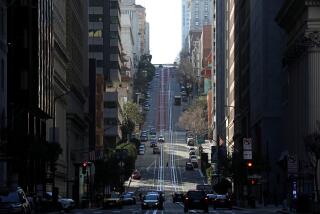Fighting for Your Rights in the Countries Still Left
- Share via
From England to Australia, and Suriname to Sri Lanka, 51 countries keep traffic to the left.
But driving the right way on the left side isn’t as easy as it sounds. If you want to tour from behind the wheel, be prepared.
Switching to the left demands concentration. Bertil Roos, who runs the School of High Performance Driving at Pocono International Raceway in Pennsylvania, warns “not to take the challenge of motoring on the left lightly.”
A well-known racing veteran, Roos has seen plenty of action in both lanes, but he still remembers how hard it can be to make the change from right to left.
“After driving in America for a few years I went back to England and found myself in the middle of a few hair-raising incidents,” Roos said. “Suddenly, you wake up and you don’t know where to go.”
Simple procedures such as leaving a gas station or making a U-turn can lead to confusion, Roos said. “At times like those, when you’re getting back into traffic there’s a tendency to relapse. If you haven’t reprogrammed yourself, your instincts are going to fail you.”
In left-side countries you’ll tend to drive slower than the residents. Your caution may inspire some of them to follow you too closely. Roos recommends ignoring such tailgaters. “They’ll either pass you or they’ll drop back, so don’t be distracted by what’s behind you. Your attention should always be forward.”
Right-Side Club
Roos’ native land is Sweden, where the rule of the road has a dramatic history. After Hungary switched to the right in 1941, Sweden was the only country on the Continent that kept left. Its closest neighbors--Denmark, Norway, and Finland--urged it to join the right-side club, and the pressure finally proved irresistible.
On Sept. 3, 1967, at 4:50 a.m., traffic all over Sweden came to a full stop. Drivers paused for a long minute, and then abandoned the left side for the right. There they paused again. These early risers were caught up in the most complex highway operation ever undertaken, but for the next 10 minutes they could only wait.
Earlier, when the government announced its decision to reverse the traffic flow, Swedes responded with humor as well as concern. It was said that the switch would be like getting up in the morning and shaving with toothpaste. Or turning on the cat and putting out the radio.
By Sept. 3, the time for pleasantries was past. When the moment arrived at 5 a.m., traffic inched ahead. Then--miracle of miracles--it started to flow. Four years of intensive planning, expenditures of $120 million and an ingrained Scandinavian tidiness combined to create a notable success.
The number of accidents in all Sweden on that special day was fewer than average. No one had shaved with toothpaste, yet Hoger Dag (Right Day) had worked.
Still, the new system took its toll. On Sept. 3-4 the police recorded 13,000 instances of drivers straying back into the left lane. Pollsters discovered that 58% of the driving population relapsed at least once during the first week following the switch.
Sweden’s switch to the right had little influence elsewhere. It’s the British we must thank (or curse) for most of the world’s left-side driving.
Staying to the Left
Wherever the sun shone and the Union Jack flew--in Ireland, South Africa, on the Indian subcontinent, in Australia, New Zealand and Jamaica--the rule of the road was the left-hand rule. Even when the British banner came down, the sun kept shining and the traffic usually stayed to the left.
There have been exceptions. The most recent occurred in 1982, when the Argentines invaded the Falkland Islands and decreed that all vehicles would henceforth keep right.
The islanders proved to be loyalists. As often as they dared, they followed the British rule. The Argies painted arrows on the road to remind them that the rule had changed. Still they drifted left. Much to their relief, British victory brought back their right to go left.
After Britain, the most influential devotee of the left lane is Japan. The United States, in the person of Gen. Douglas MacArthur, missed a golden opportunity to convert the entire nation to the right side in late 1945.
At that time, few Japanese owned cars and most of their cities were in dire need of rebuilding. If MacArthur had advocated it, the change probably would have taken place.
As early as 1913 an international committee had reported that the world’s two competing rules of the road were an “outstanding source of danger and difficulty” and recommended one rule for all countries.
The guns of August, 1914, drowned out that voice of reason, and by the time World War I ended, motor traffic had increased so much that the reformers lost heart. There has never been another call for world uniformity.
Will Britain and Japan ever move from left to the right?
The answer is no, according to Peter Kincaid, an Australian scholar who has published an important study on the rule of the road.
Kincaid said that over time the cost of switching the flow of traffic in an industrialized country “not only increases, but increases geometrically.” It would be too expensive, he believes, for countries like Britain and Japan to change.
Driving Tips
It appears that far-wandering drivers would do well to hone their left-side skills. Here are a few more tips:
--”Put the passenger in the ditch.” This is not a formula for abandoning a cranky traveling companion. It’s the advice of an American airline pilot who has driven many miles on the left.
Happily, the slogan works anywhere in the world. In countries where you drive on the left, the steering wheel is on the right side of the car and the passenger seat is next to the shoulder or ditch. In the event of an emergency you’d normally swerve to the passenger’s side--the left--and out of the path of oncoming traffic. A strong sense of that will keep you on the left side of the road.
--And speaking of passengers, an alert person in the left seat can be an invaluable asset on your journey through Britain or Japan, Tanzania or Malaysia. Job qualifications include an ability to read maps and a willingness to repeat “Keep left!” in a fervent voice at frequent intervals.
--Don’t rush your car into left-lane traffic when you are suffering from jet lag or you could end up on the wrong side of the road. Allow your body a day or two to adjust.
--Try to rent a car with an automatic transmission. It’s bad enough to be sitting on the wrong side of the car and driving on the wrong side of the road without having to work a gearshift with your left hand and use the turn signal with your right.
You can’t avoid a standard shift? Then proceed with caution, and realize that things could be worse. At least the positions of clutch, brake and accelerator are the same throughout the world.
--Many accidents occur at intersections, so be wary of them, especially when visibility is reduced by trees, houses or other vehicles. Pause at blind corners and ask yourself, “If a car suddenly appears here, which lane is it going to be in?” Don’t turn until you’re sure of the answer.
--Backing your car in a country where traffic keeps left can be tricky. Ignore the rear-view mirror or you’re liable to get a sudden, confusing sense of being trapped backward in a turned-around world. A simple technique will keep you out of trouble: Instead of dealing with the mirror image, swivel your head around and look where you’re going.
Because you’ll be walking as well as driving abroad, the same sort of caution is needed afoot as behind the wheel. Remember, if you’re from a right-side country like the United States, you’re used to looking left before crossing the street. In a left-side country, you have to look to the right.
Other Roadblocks
Be sure to check with your travel agent or a tourist authority before settling on a destination where you can try this advice. There could be additional complications. In places such as India and Indonesia, rental cars are hard (or impossible) to come by. A few countries have laws against any tourist driving a car while vacationing there. The island of Bermuda is a case in point.
Though Bermudans are famous for their friendliness and hospitality, they refuse to be overrun by four-wheeled vehicles.
Pamela H. Wissing, head of information services at the Bermuda Department of Tourism in New York City, said tourists “are very surprised to find out that they aren’t allowed to drive in Bermuda. Our traffic keeps left, but that’s not the reason for the restrictions. It’s because our streets are very narrow, and the island is only 20 miles long, and we don’t want to add to the congestion.”
Plenty of alternative modes of transportation exist, from taxis to buses to motor scooters to bicycles to horse-drawn carriages. But there are no cars for rent. You aren’t even allowed to borrow an islander’s car. People who understand the situation don’t seem to mind; some of them like Bermuda because it gives them a vacation from driving.
Others will find such restrictions galling. Their spokesman might be the perceptive critic and author Paul Fussell, who has pointed out the difference between the adventurous travel of yesteryear and the tamer pleasures of contemporary tourism.
“Perhaps the closest one could approach an experience of travel in the old sense today,” Fussell said, “would be to drive in an aged automobile with doubtful tires through Romania.”
But who needs Romania and who needs doubtful tires? Countries with left-side traffic offer sights as diverse as the Great Rift Valley of Kenya, the geysers of Rotorua in New Zealand and the sacred city of Nikko in Japan. Arriving at such scenes in the left lane should be adventure enough for anyone.
More to Read
Sign up for The Wild
We’ll help you find the best places to hike, bike and run, as well as the perfect silent spots for meditation and yoga.
You may occasionally receive promotional content from the Los Angeles Times.






